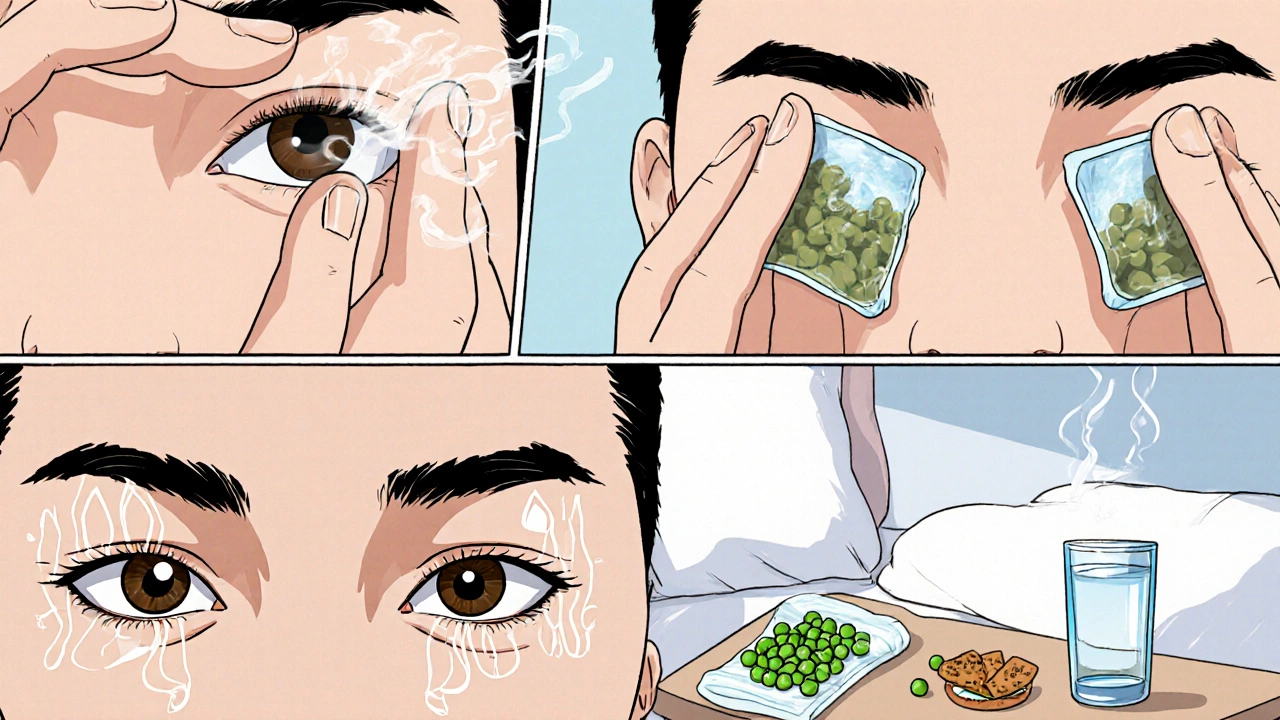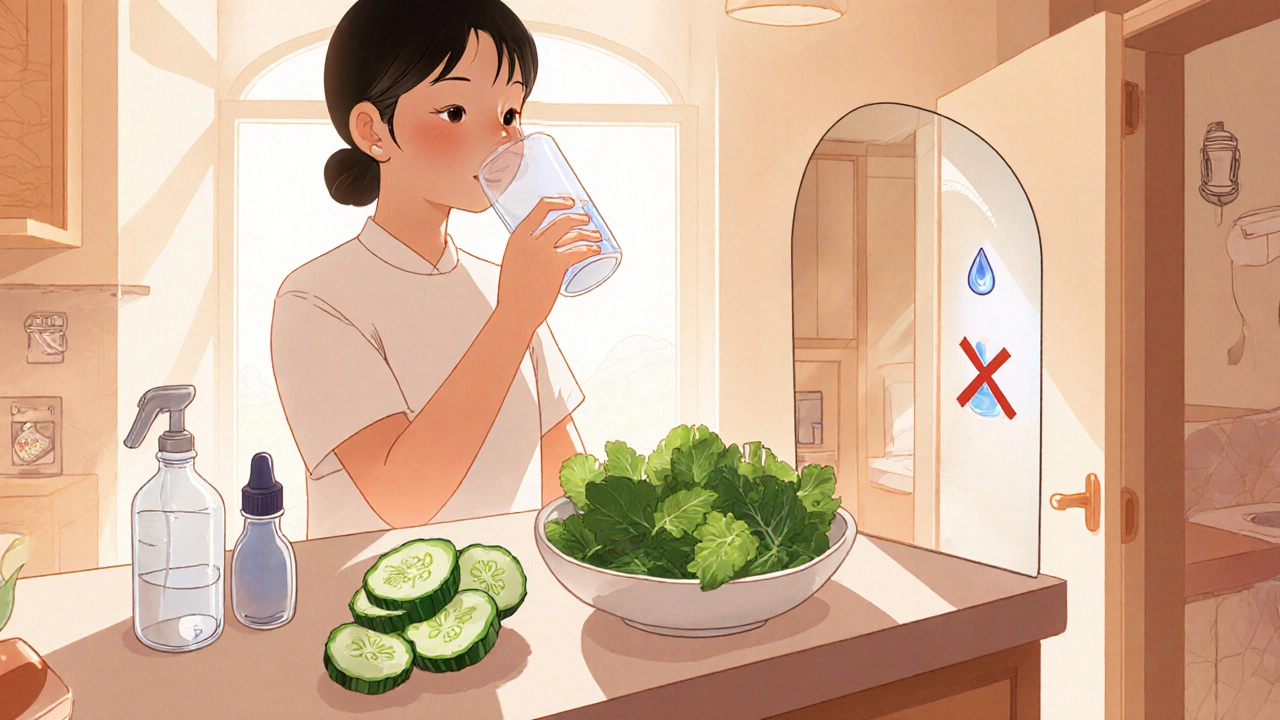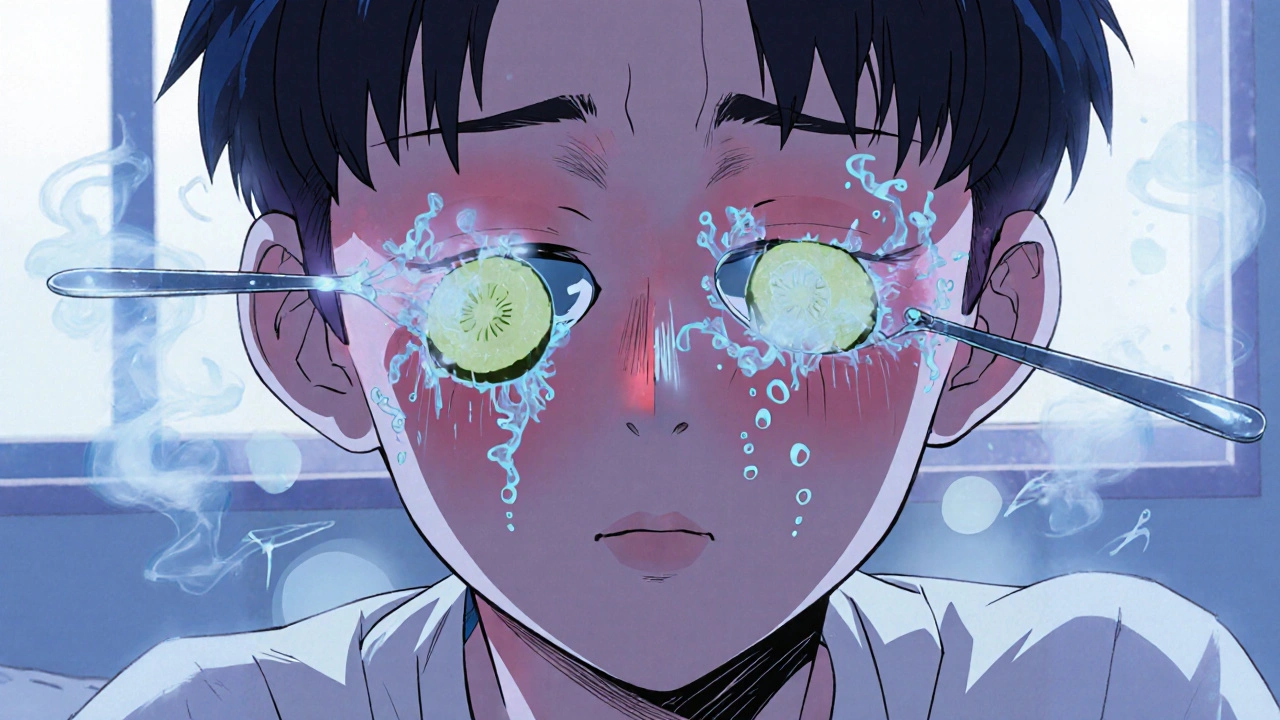Eye Swelling Remedy Recommender
Choose your current situation and available remedies to get personalized recommendations for reducing eye swelling after crying.
Key Takeaways
- Cold compresses work fastest because they shrink blood vessels.
- Gentle pressure and elevation stop fluid from collecting.
- Natural items like cucumber or tea bags add soothing antioxidants.
- If swelling persists more than 24 hours, check for allergies or infection.
- Stay hydrated and limit salty foods to prevent future puffiness.
When you cry, eye swelling after crying is the temporary puffiness around the eyelids caused by fluid buildup and inflamed blood vessels. This feeling of pressure can make you look exhausted even after the tears dry up. Below you’ll learn how to calm that puffiness fast and keep it from coming back.
Why Your Eyes Swell After Crying
Every tear starts its journey in the tear ducts that line the inner corner of each eye. Crying releases a salty solution that draws water into the surrounding tissue through osmosis. At the same time, the emotional stress of crying triggers tiny blood vessels - called capillaries - to expand, letting more blood flow into the area. The combination of extra fluid and dilated capillaries creates the classic puffiness you see in the morning after a sob session.
Salt in the tears also irritates the skin, causing a mild inflammatory response. Histamines are released, which further increase swelling. If you have a pre‑existing condition like allergic conjunctivitis, the reaction can be even more pronounced because your eyes are already primed to react to irritants.
Immediate First‑Aid Steps
- Sit upright or stand. Raising your head above heart level lets gravity pull excess fluid away from the eye area.
- Apply a cold compress for 10‑15 minutes. The cold causes the blood vessels to constrict, which reduces the amount of fluid that can leak into the tissue.
- Gently tap the swollen area with clean fingertips. Light pressure encourages lymphatic drainage without bruising the delicate skin.
- Pat the skin dry with a soft towel - avoid rubbing, which can irritate the already sensitive tissue.
If you don’t have a ready‑made cold pack, a spoon that’s been chilled in the freezer or a bag of frozen peas wrapped in a cloth works just as well.

Home Remedies That Really Help
Beyond the classic ice pack, a few kitchen staples can speed up recovery.
- Cucumber slices are naturally cool and contain antioxidants that calm inflammation. Place a chilled slice on each closed eyelid for 10 minutes.
- Steep two tea bags in hot water, let them cool, then refrigerate for 20 minutes. The tannins in tea bags act as astringents, tightening the skin and reducing fluid leakage.
- A chilled metal spoon can be pressed gently against the inner corner of the eye. The metal holds cold longer than fabric, giving a deeper chill.
These remedies not only lower temperature but also deliver soothing moisture that prevents the skin from drying out - a common side‑effect of prolonged crying.
When Over‑the‑Counter Aids Are Worth It
If you frequently experience puffiness, an antihistamine eye drop can block histamine release and keep swelling at bay. Look for drops that contain ketotifen or olopatadine. They are safe for occasional use and can be especially helpful when your swelling is linked to seasonal allergies.
For most people, a single drop in each eye after cleaning the lids is enough to calm the tissue within 20‑30 minutes. Pair drops with the cold compress routine for best results.

Long‑Term Habits to Keep Puffiness at Bay
Even if you master the quick‑fix steps, recurring puffiness often signals an underlying habit.
- Stay hydrated. Drinking at least eight glasses of water a day dilutes the salt concentration in your tears, reducing the osmotic pull that draws fluid into the eyelids.
- Watch your sodium intake. Processed foods, salty snacks, and fast‑food meals increase overall body fluid retention, which shows up first in the delicate eye area.
- Address sinus pressure. Congested sinuses can force fluid into the eye sockets. A saline rinse or a short‑term decongestant can relieve that pressure.
- Manage allergies. If you notice that your eyes swell after exposure to pollen, pet dander, or dust, consider an oral antihistamine or a HEPA air filter at home.
- Gentle eye hygiene. Removing makeup before bed and using a mild, fragrance‑free cleanser prevents extra irritation that can aggravate swelling.
Combining these habits with the immediate steps creates a two‑pronged approach: rapid relief now and fewer episodes later.
Quick Comparison of Popular Remedies
| Remedy | Temperature | Typical Duration | Key Benefit | Possible Drawback |
|---|---|---|---|---|
| Cold compress | Cold (0‑5 °C) | 10‑15 min, repeat as needed | Immediate vasoconstriction reduces fluid | Can be uncomfortable if skin is very cold |
| Warm compress | Warm (35‑40 °C) | 5‑10 min, once | Improves circulation, helps clear blocked glands | May increase swelling if used too early |
| Cucumber slices | Cool (4‑7 °C) | 10 min | Ash antioxidant content calms irritation | Requires refrigeration, short shelf life |
| Tea bags | Cool (5‑8 °C) | 10‑15 min | Tannins act as astringents, reduce fluid leakage | May stain skin if left too long |
Frequently Asked Questions
Can I use a heating pad instead of a cold pack?
A heating pad is useful once the initial swelling has gone down because it helps clear blocked oil glands. In the first hour after crying, stick with cold to shrink the blood vessels.
Why do my eyes stay puffy for days?
Prolonged puffiness often signals an underlying issue such as allergies, sinus congestion, or high salt intake. Addressing those root causes alongside the immediate steps will shorten recovery time.
Are over‑the‑counter eye drops safe for daily use?
Antihistamine drops are safe for regular use if you have chronic allergy‑related swelling. For occasional puffiness, stick to cold compresses and natural remedies.
Can I apply makeup after using a cold compress?
Wait until the skin is completely dry and any redness has faded. Applying makeup on damp skin can trap moisture and cause the swelling to return.
How often should I repeat the cold compress?
You can repeat the 10‑minute cold compress every hour for the first few hours. After that, once‑or‑twice a day is enough to keep any residual puffiness at bay.

Crying is a natural response, and those puffy lids can feel like a badge of honesty. The cold compress is your fastest ally – it shrinks those capillaries and pumps the fluid right out. A chilled cucumber slice adds a soothing antioxidant boost while keeping things gentle on delicate skin. If you have a spare tea bag, the tannins work like a mini‑spa for your eyes. Remember to stay hydrated and keep salty snacks at bay, and you’ll bounce back brighter than ever! 🌟😊